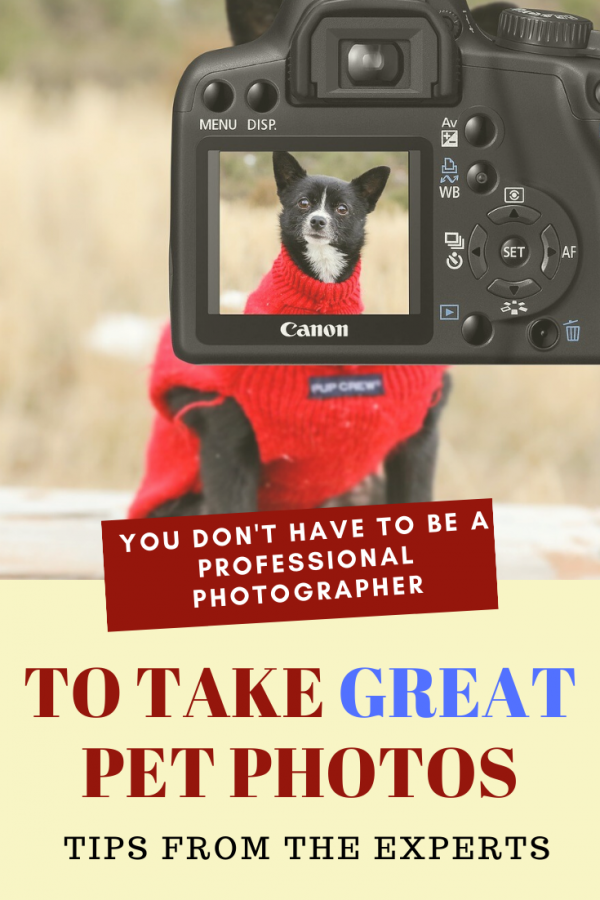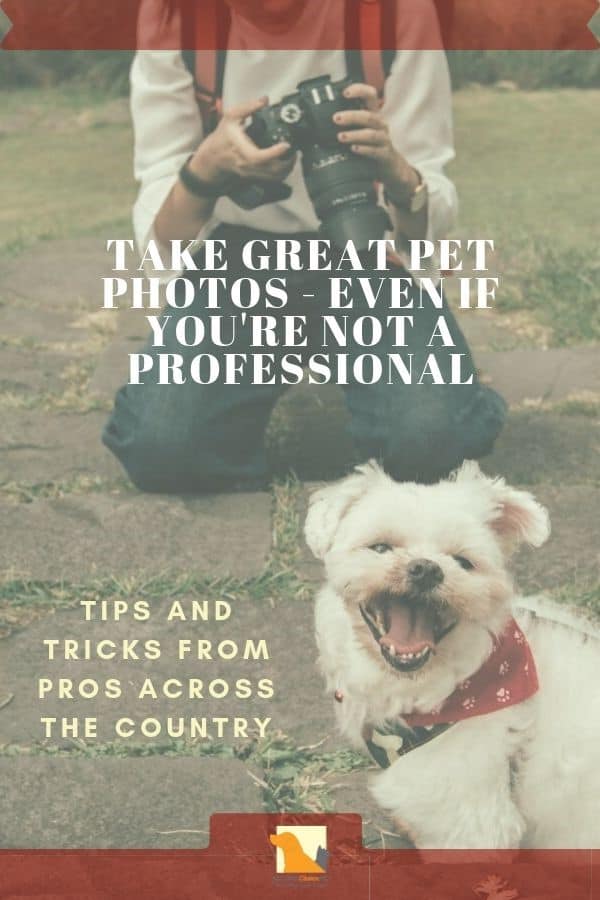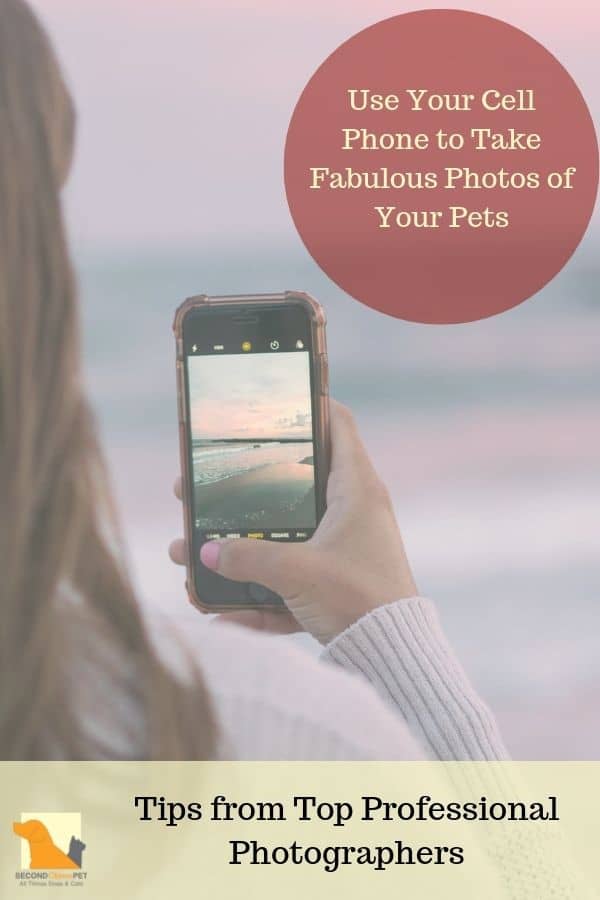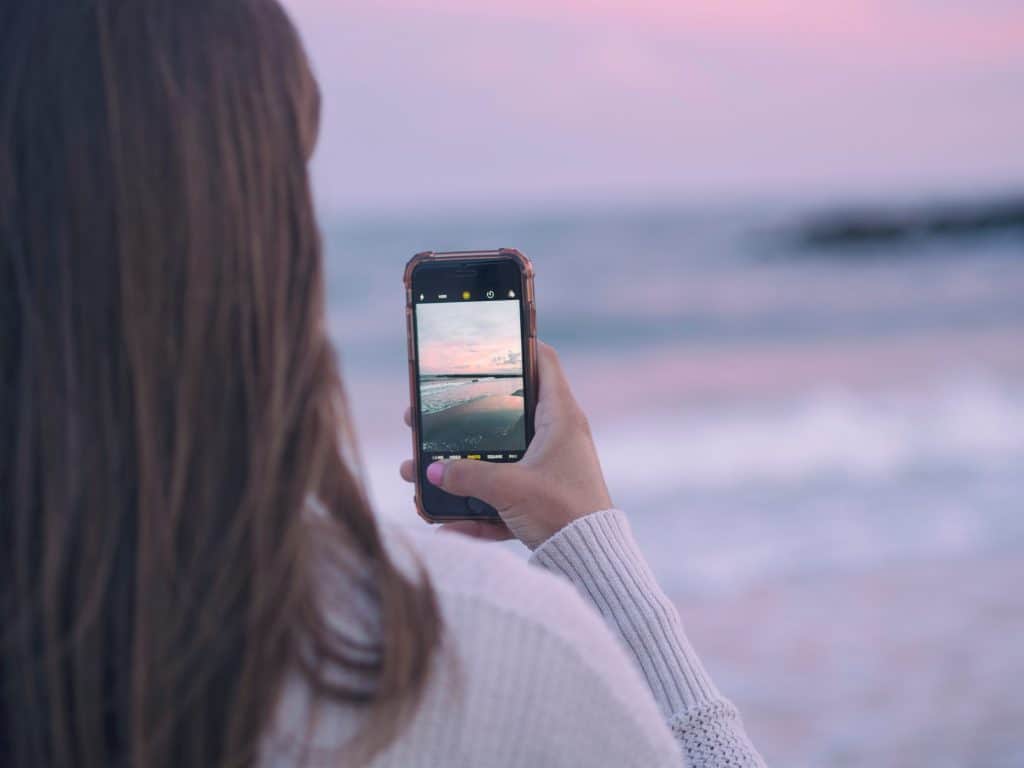HOW TO TAKE GREAT PET PHOTOS. PROFESSIONAL PET PHOTOGRAPHERS ACROSS THE COUNTRY SHARE THEIR BEST TIPS
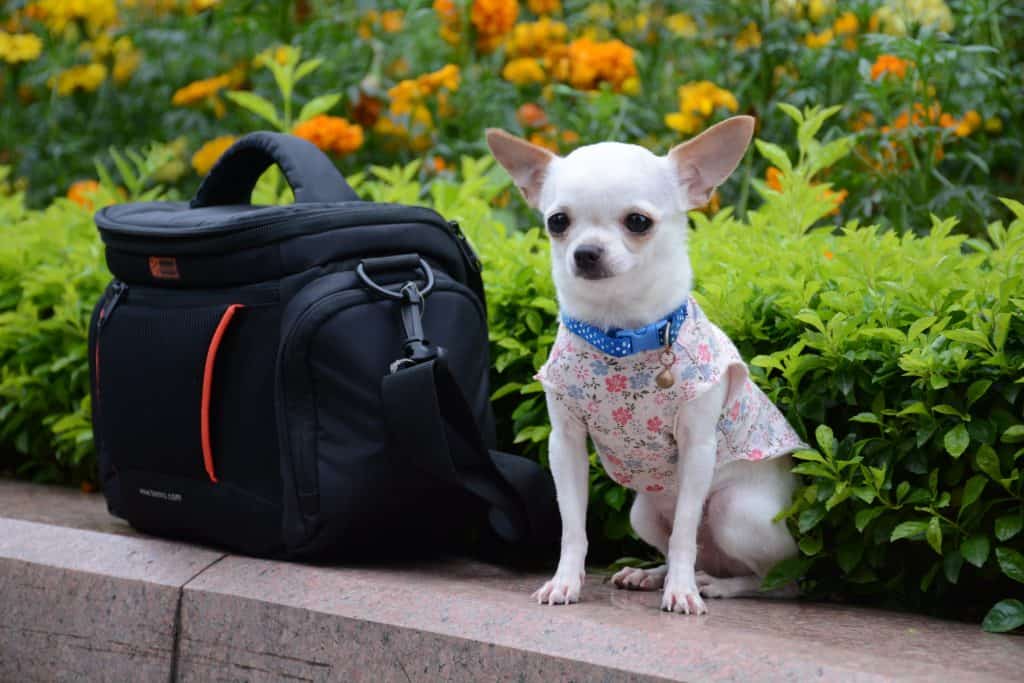
We all want to take great pet photos. Whether we’re sharing on Facebook or Instagram, we want our furry family members to look their best. If you’ve ever whipped out your phone to show strangers pictures of your pups or kitties, even without being asked, this post is for you. These pet photography tips from professionals can help you take photos you’ll be proud to share.
PHOTO CONTROLS ON YOUR PHONE
Before you can take really good photos, you’ll need to learn how to use all the capabilities on your phone’s camera. There are some amazing features built into that “we use it for everything but making phone calls” device in your back pocket or purse. For example, portrait mode, which focuses on a face (furry or not), and blurs the background; manual focus, so you can bring one object into focus while the rest of the photo blurs; and many other tricks. Each improvement to your cell phone brings with it more and more functions similar to those of a much more expensive camera.
There are several websites where you can learn how to use the full capabilities of your cell phone. For the iPhone, try iPhone Photography School. For your Samsung Galaxy, try here: 25 Tips for Taking Better Photos on Your Samsung Galaxy A Google search will bring up all sorts of resources to learn mobile phone photography.
PET PHOTOGRAPHY TIPS FROM THE PROFESSIONALS
LIGHTING
All of the professional photographers I spoke with counted this as number one in importance when taking good pet photos.
Yvonne Niemann of Yvonne Niemann Photography says that you should look for the best light first. “An open area in front of the animal is best. Think an open door or window if you are indoors, if outdoors put your animal in front of an open space where there is some sky showing.” Her best tip – “Hold your hand in a fist and move yourself around. When you see the light hit your fist at the brightest and most even, that is your best light.”
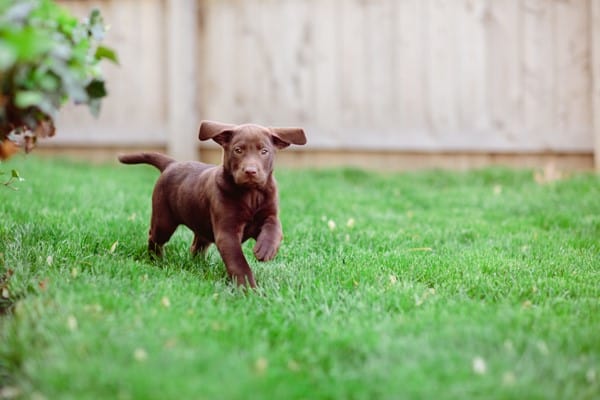
Travis of Lovelee Photography says the best time of day for outdoor photography is 30 minutes before sunset. Overhead sun creates harsh lighting and shadows. “If you are taking photos earlier in the day, try to find a shaded area where the lighting is more even, avoiding spots of light coming through. Try to keep the sun behind your pet.”
USING FLASH
Nick Graf says “Using flash is generally going to give you bad results.” So, avoid turning on the flash on your phone, and, if it’s set on Auto, turn it off. He added “Try to keep your pet centered in the photo. The camera is set to weigh the content towards the center of the frame at the highest priority.”
OUTDOOR VERSUS INDOOR PHOTOGRAPHY
For those of us who are amateurs without access to professional lighting, the photographers I spoke with recommended outdoor photography as opposed to indoor. However, if you want to take photos when the sun is high in the sky, you’re better off indoors. Try to capture your pet while it is standing in an open window or door.
Nick Graf says “your eyes are much more sensitive than your camera’s sensor, so what looks normal indoors is usually pretty dark to your camera.” He suggests shining a light at the ceiling above your pet, particularly if the ceiling is white. Reflected light is much less harsh than direct lighting and your photos will show this. He suggests that you use a stuffed animal instead of your pet to experiment with the best lighting.
Wendy Wooley of Peeps and Paws says smart phones are not at their best indoors with poor lighting.
The takeaway – take your photos outside, within 30 minutes after sunrise or 30 minutes before sunset, for the best lighting possible.
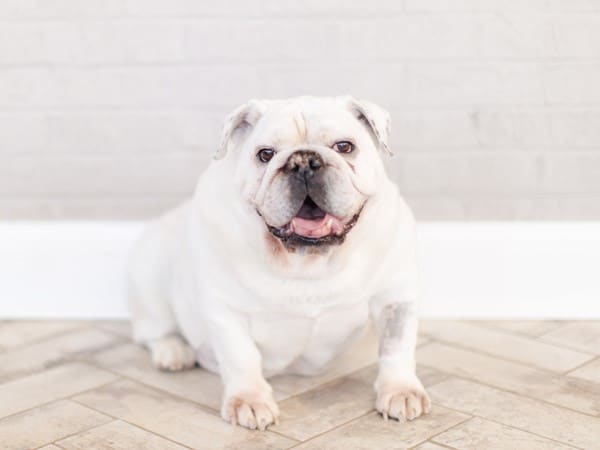
PHOTOGRAPHING KIDS AND PETS TOGETHER
The professionals who answered this question said this was tricky, particularly with young children. Both kids and pets are naturally disinclined to sit still for long. If you’re looking for a portrait style photo, you’ll need loads of patience.
Nick Graf suggests trying to find a squeaky toy that will capture both the pet’s and the child’s attention. Using a helper behind you to draw the attention of both, snap your photos quickly before the instant passes.
Travis of Lovelee Photography suggests not trying to get a formal photo with the smaller ones. He says “allow your pet some time to relax and then introduce your child.” Make sure your child is interacting calmly with your pet, and then wait, and wait. Eventually you may get a cute candid photo of the two together.
TAKING PHOTOS OF A BLACK PET
Having owned a black pet (with a tiny bit of white on her chest), I can testify how difficult it is to get a clear photograph which looks like something more than a pile of fur with eyes. That’s why I believe black shelter pets are usually the last to get adopted. When looked at in a darker kennel run, their features don’t stand out, and so very few people ask to see them outside their cages.
Anyway, the answer of our photographers all centered around lighting. Wendy Wooley of Peeps and Paws said, when planning outdoor photography, “shoot with your back to the sun and have the background not contrast strongly with the black fur.” She suggests using tall ornamental grass, for example.
Michelle Conner of Michelle Conner, Photographer suggests using open shade – “the type of shade a large tree or tall building create” instead of sunlight, if you must shoot on a sunny day.
Nick Graf reiterates that you should not use your phone’s built-in flash as it will accentuate shadows and not do your pet justice.
GETTING YOUR PET TO COOPERATE
This is a difficult one for me as I have one dog who will turn around and leave if I point my phone at her. She’s fine if I’m looking at my phone, but once I point it at her, she takes off. Not quite sure what she thinks is going to happen to her……………
Anyway, there were plenty of ideas among the photographers I spoke with. Nick Graf says that you shouldn’t expect an energetic pet to sit still for a portrait (unless they’re asleep). He suggests planning plenty of time (and taking plenty of photos). “I promise you, for every one picture I’ve taken that I’m proud of, I can show you a hundred I took that led up to that one special moment.”
Wendy Wooley and Michelle Conner both say finding the right noises, whether from a YouTube video, a recording, or made by you, can lead to lots of cute head tilts and ear pricks. Try bird sounds, or other animal noises.
Travis of Lovelee Photography does not recommend using treats. In his experience, once the animal smells a treat, all possibility of cooperation fades away. In order to grab the pet’s attention, he whistles or makes kissing noises to get upright ears and attention on the camera.
Katie Nolte of Galloping Dreams Photography brings duck calls, goose calls, elk calls, as well as a coyote cry to attract the attention of dogs who are REALLY not interested. She says she sticks with using only one attention-getter. Using more just overstimulates the animal. She has a vast amount of experience doing shelter photography, and often uses bits of chicken to capture the perfect treat-catching photo.
As for working with cats, Katie says the most interesting toy to use to stimulate activity is one with feathers. She also uses smell food with cats “who may otherwise just give us the grumpy cat face”. Rubbing together candy wrappers is another of her secrets to get her subject’s attention – she says some cats absolutely love the sound.
DO YOU NEED A HELPER?
All of the photographers agreed that a helper (or 2) is imperative in order to get the best photos of your pets. Yvonne Niemann uses a helper to hold treats over the camera while she shoots. This draws the pet’s attention to the treat and Yvonne can get a good photo of the animal looking directly at the camera.
Katie of Galloping Dreams Photography takes a lot of photos for local shelters and rescues. She uses shelter staff for her helpers, but limits them to no more than three. More helpers can cause more anxiety in the rescue pets she’s photographing.
For non-rescue pet photography, Michelle Conner has one helper for every pet involved. This will include the owner giving a stay or sit command, and someone standing behind her camera with a treat, a squeaky toy, or performing a goofy action like a jumping jack to get the animal’s attention.
Nick Graf often uses a helper. His assistant will hold the dog 30 yards away while he focuses, then let them go for an action photo of the pet running towards its owner.
PHOTOGRAPHING SHELTER PETS
In an earlier post, I talked about all the various ways you can help your local animal shelter. One of these ways was to write-up adoptable pets for Facebook. These posts will get even more attention with photography that shows the pet’s personality.
Wendy of Peeps and Paws strongly recommends not having a fence or wire in the photo. She says “Cages only get sympathy, but not necessarily adoption.”
DOGS
Katie from Galloping Dreams Photography has loads of experience in shelter photography. She recommends letting dogs run for at least 10 minutes before attempting to take photographs. Shelter dogs are already anxious – it helps to let them tire out a bit before introducing a camera. She starts by taking active photos – dogs running, jumping, playing with each other if the shelter is set up for play groups. Then she does her portrait shots, and then a head shot.
Katie says not to rush. Since a photographer is not going to be knowledgeable about the personality of each dog, it’s imperative to allow all the time necessary for the animal to become comfortable. Stop if you see that your activity is making the dog nervous. A photo of a nervous dog won’t help get it adopted, and anxiety can turn into aggression if not alleviated.
Wendy says she uses cute props, like scarves she picks up from Goodwill, to create novelty photos.
Nick suggests getting down at the dog’s level, but only after consulting with shelter staff. Although many dogs will run up to a human laying on the ground, a few will be frightened and that will spoil any photos you may be able to take.
CATS
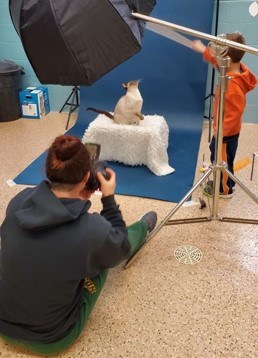
Galloping Dreams Photography will go to a shelter and take photos of 50 to 70 cats in a couple of hours. This requires strategy and organization. Katie suggests using a raised cat bed to eliminate the need for stooping and bending. Turning the cat to either face any lighting you may have, or turned slightly away will cause the eyes to be highlighted and produce a stunning photo.
For shy cats, Katie works quickly, offers treats, and snaps the images she needs. For more approachable cats, she finds that they love stools. They’ll lay with their front paws hanging off and look right into the camera. There’s nothing better for an adoption photo than an animal who engages with the camera.
IN SUMMARY
Here are some pet photography tips to remember:
First, learn your cell phone’s capabilities. All of the different brands are becoming more and more advanced with each update. You can now change your aperture settings, the brightness of your photos, and your shutter speed if you have the latest phone. Don’t use the built-in flash if at all possible – it makes shadows harsher and washes out the detail.
Then, have fun trying to take the best photos of your pet and share to your social networks. You’ll cherish these photos for the rest of your life!
MY THANKS
To the following photographers who gave of their time and knowledge to answer my questions:
Yvonne Niemann – Yvonne Niemann Photography – Athens, GA
Travis Lovelee – Lovelee Photography – Scottsdale, AZ
Wendy Wooley – Peeps and Paws Photography – Lexington, KY
Nick Graf – Former professional photographer – Falling Waters, WV
Katie Nolte of Galloping Dreams Photography – Richville, MN
Michelle Conner of Michelle Conner Pet Photographer – Nashville, TN
ADDITIONAL THANKS
To Barbara Keech of Barbara Keech Photography who introduced me to the world of pet photography – Martinsburg, WV
To Carrie Angel of Carrie Angel Photography who took profile photos of me and my dogs when I started this blog and again when the seasons changed – Charles Town, WV
Photo of woman using cell phone to take a photo by Aaron Burden on Unsplash
Photo of chihuahua sitting by camera bag by thanh hien on Unsplash
Photo of dog framed in a camera by No-longer-here from Pixabay